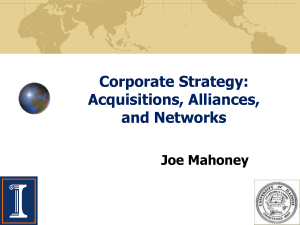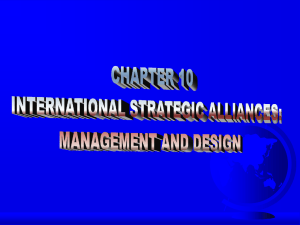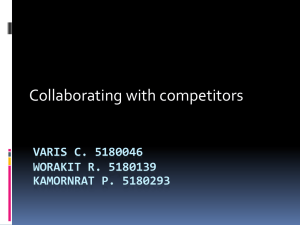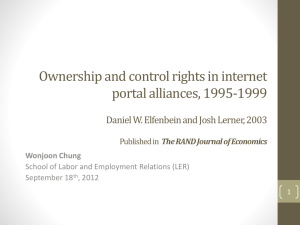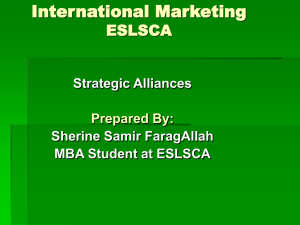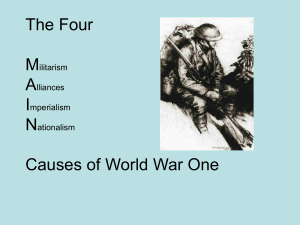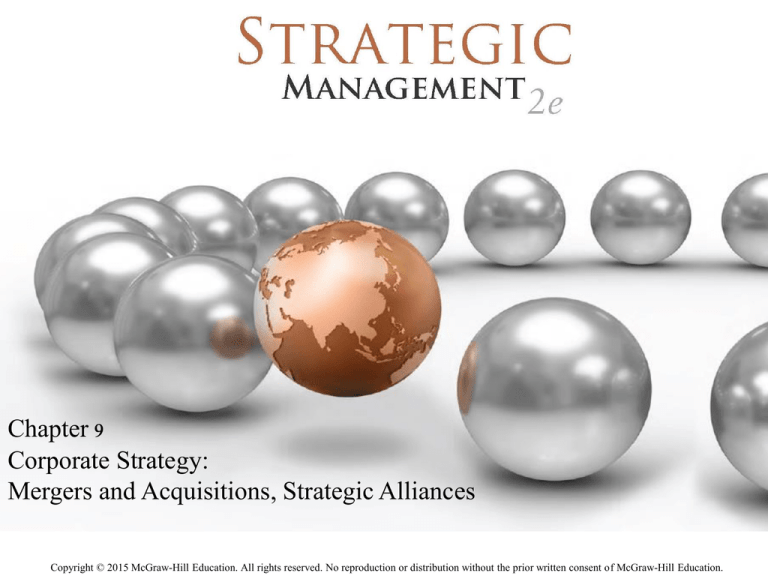
Chapter 9
Corporate Strategy:
Mergers and Acquisitions, Strategic Alliances
Copyright © 2015 McGraw-Hill Education. All rights reserved. No reproduction or distribution without the prior written consent of McGraw-Hill Education.
9-2
Chapter Outline
9.1 Mergers and Acquisitions
• Merging with Competitors
• Why Do Firms Make Acquisitions?
• M&A and Competitive Advantage
9.2 Strategic Alliances
• Why Do Firms Enter Strategic Alliances?
• Governing Strategic Alliances
• Alliance Management Capability
9.3 Implications for the Strategist
9-3
ChapterCase 9
©Disney, Todd Anderson/AP Images
How Buzz Lightyear, Iron Man, and Darth Vader Joined
Mickey’s Family
Disney earns over $45 billion in revenues − major
purchases:
• 2006 – acquired Pixar for $7.4 billion
After Eisner left Disney in the fall of 2005
• 2009 – acquired Marvel Entertainment for $4 billion
• 2012 – acquired Lucasfilm for over $4 billion
Disney uses alliances and acquisitions for
complementary assets.
• Related-linked diversification (see Ch. 8)
9-4
9.1 Mergers and Acquisitions
Merger: combining two companies usually similar in size
• Friendly approach
Ex: Ernst & Young
Acquisition: purchase or takeover of a company
• Can be friendly
Ex: Disney buys Pixar
• Hostile takeover
Ex: Vodafone buys Mannesmann
9-5
Merging with Competitors
Horizontal integration: process of merging and
acquiring competitors
• HP buys Compaq in 2002.
• Pfizer buys Wyeth in 2009.
• Live Nation buys Ticketmaster in 2010.
Benefits:
•
•
•
•
Reduce competitive intensity
Lower costs
Increased differentiation
Access to new markets and distribution channels
9-6
Strategy Highlight 9.1
Food Fight: Kraft’s Hostile Takeover of Cadbury
Kraft acquired Cadbury in UK.
• Hostile takeover, $20 billion deal
• Cadbury has strong position in emerging economies.
Perfected distribution system in countries like India
• Kraft faces strong rivalries worldwide, including China.
2012 − Kraft restructured
With Hershey’s attention on China (2013 entry), Kraft
has an opportunity for gaining U.S. market share.
9-7
M&A and Competitive Advantage
Many M&As actually destroy shareholder value!
• When there is value, it often goes to the acquiree.
• Acquirers tend to pay a premium.
Why still desire M&As?
• Principal–agent problems
• Overcome competitive disadvantage
• Superior acquisition and integration capability
9-8
9.2 Strategic Alliances
STRATEGIC ALLIANCE
• A voluntary arrangement between firms that involves the sharing of
knowledge, resources, and capabilities with the intent of developing
processes, products, or services
STRATEGIC CRITERIA
• An alliance qualifies as strategic only if it has the potential to affect a
firm’s competitive advantage.
RATIONAL VIEW OF COMPETITIVE ADVANTAGE
• Framework where critical resources and capabilities are embedded in
strategic alliances that span firm boundaries
9-9
Why Do Firms Enter Strategic
Alliances?
Strengthen competitive position
• Apple vs. Amazon
Enter new markets
• Local partner for global growth
• Microsoft partners with Yahoo on search
Hedge against uncertainty
• Real options approach
Roche invests in Genentech 1990 & buys it in 2009
Access critical complementary assets
• Pixar partners with Disney
Learn new capabilities
• GM & Toyota (NUMMI) – formed in 1984
Who won the learning race? Probably Toyota….
9-10
Strategy Highlight 9.2
Strategic Alliances to Challenge Amazon
Amazon’s Kindle
• Content providers do not want fixed price for e-books. ($9.99)
• Below cost is the same strategy Amazon started for printed books.
Apple’s iPad
• Let publishers set the prices directly (Agency model)
• Worked with publishers to increase bargaining power
Challenge Amazon’s early lead in the delivery of e-content
• Amazon share dropped from 90 to 60% in e-books.
2013 – a federal judge ruled that Apple colluded with
publishers to drive up prices of e-books
9-11
Exhibit 9.2 Key Characteristics of
Different Alliance Types
9-12
NON-EQUITY ALLIANCES
Most common forms of alliance
• Supply agreements
• Distribution agreements
• Licensing agreements
Vertical strategic alliances
Firms share explicit knowledge
• Knowledge that can be codified
Patents
User manuals and fact sheets,
Scientific publications
9-13
EQUITY ALLIANCES
At least one partner takes partial ownership position
• Stronger commitment toward the relationship
Allow the sharing of tacit knowledge
• Tacit knowledge concerns the “know-how”
Partial ownership, thus equity alliances signal
stronger commitments
Moreover, equity alliances allow for the sharing of
tacit knowledge that can not be codified.
• Toyota has an equity alliance with Tesla.
9-14
JOINT VENTURES
Joint ventures (JVs) are the strong ties, trust, and
commitment that can result.
Created and owned by two or more companies
• Hulu owned by NBC, ABC, and Fox
Long-term commitment
• Exchange both tacit and explicit knowledge
• Frequent interaction of personnel
Used to enter foreign markets
Least common of the 3 types of alliances
9-15
Alliance Management Capability
A firm’s ability to effectively manage three alliancerelated tasks concurrently
30 to 70% of all alliances yield disappointing results
1. Partner selection and alliance formation
2. Alliance design and governance
3. Post-formation alliance management
9-16
PARTNER SELECTION AND ALLIANCE FORMATION
The expected alliance benefits must exceed its costs.
One or more of the five alliance formation reasons
should be present:
1.
2.
3.
4.
5.
Strengthen competitive position
Enter new markets
Hedge against uncertainty
Access critical complementary resources
Learn new capabilities
Partner compatibility and commitment are necessary
conditions for a successful alliance.
9-17
9.3 Implications for the Strategist
A strategist has three options to drive firm growth:
• Organic growth through internal development
• External growth through alliances
• External growth through acquisition
The build-borrow-or-buy framework:
• Aids strategists in deciding whether to pursue internal
development (build)
• Enter a contract arrangement or strategic alliance (borrow)
• Acquire new resources, capabilities, and competencies
(buy)
9-18
Exhibit 9.5 How to Implement a
Corporate Strategy: The Build-Borrow-or-Buy
Framework
9-19
ChapterCase 9
©Disney, Todd Anderson/AP Images
Consider This…
• CEO Bob Iger’s acquisition-led growth strategy
• Disney has become increasingly diversified
• Business revenue streams are more predictable.
• Box office, home entertainment, theme parks, cable TV,
toys, licensing, etc.
• Media industry is being disrupted:
• People spend less time watching movies in theaters.
• More time-consuming content is available online.
9-20
9-21


